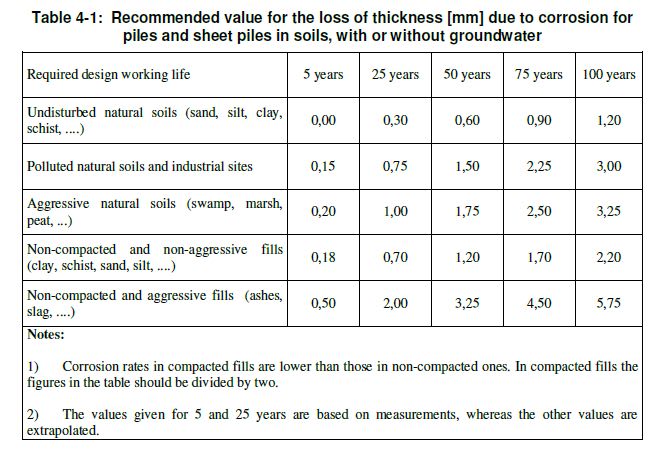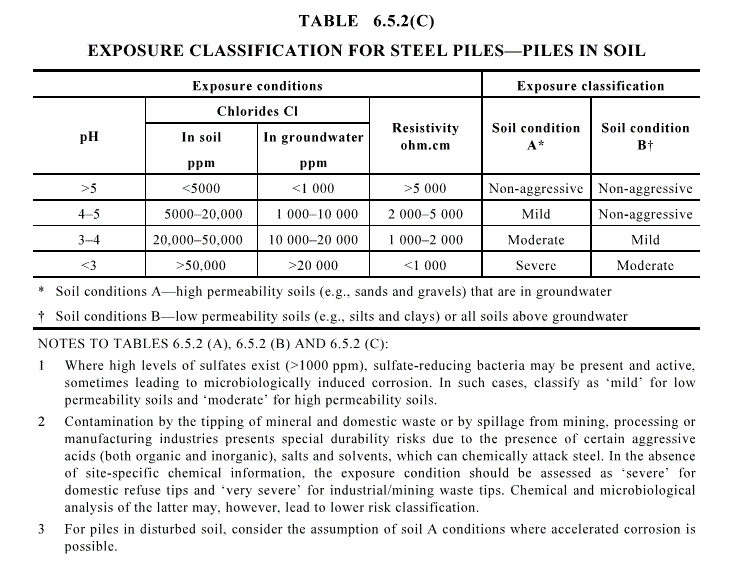Design a structure on piles in a coastal environment subject to liquefaction and just had some basic questions on pile design in general:
1) What code governs steel pipe pile, H Pile, or concrete filled pipe pile design. Reading old threads on Eng Tips and they talk about a corrosion allowance for the wall thickness, and they mention 0.08 mm/year or something similar, as a low end. What code is that specified in? They then talk about the design life of the structure as being only 50 years . . . is there a standard of care specified for what design life would be appropriate. I presume you would simply base your design capacity on the pile shape subtracting out the thickness from corrosion based on corrosion per year
2) What goes into determining wall thickness on a pipe pile. We haven't got a full geotechnical report yet, but know the general capacity of an 18" diameter pipe pile is 245 to 280 kips. I know the basics out of the IBC: 5 to 10 feet of unbraced length is required, and that IBC has further guidelines based on the selected hammer for the pile. But a 10'-0" tall column with a 1/4" wall is easily good for 245 kips. Yet neighboring projects have 1/2" wall or are 16" driven pipes with concrete and a full rebar cage.
2) What factors determines whether you should place concrete into the pipe pile (already understand that for this pile type it would be driven closed ended and cleaned out before concrete placement). Does it just increase the load capacity of the pile. Is the design based on the composite shape or the concrete only (for instance, if you would suspect that the steel would eventually rust away)?
3) What would make you choose an H-pile over a pipe pile? Is it simply between availability, price or a local preference, or is there an engineering reason for one over the other?
3) How does liquefaction affect the unbraced length of the pile? If you have deep deposits of sand and very tall piles, treating the piles as totally unbraced columns would require very large piles just to have a kl/r less than 200.
Mostly looking for a design reference on these. I have CRSI's Drilled Piers design guide, but looking for something similar that covers steel and concrete filled pipe piles. We don't own L-pile and will have the geotechnical engineer cover that.
1) What code governs steel pipe pile, H Pile, or concrete filled pipe pile design. Reading old threads on Eng Tips and they talk about a corrosion allowance for the wall thickness, and they mention 0.08 mm/year or something similar, as a low end. What code is that specified in? They then talk about the design life of the structure as being only 50 years . . . is there a standard of care specified for what design life would be appropriate. I presume you would simply base your design capacity on the pile shape subtracting out the thickness from corrosion based on corrosion per year
2) What goes into determining wall thickness on a pipe pile. We haven't got a full geotechnical report yet, but know the general capacity of an 18" diameter pipe pile is 245 to 280 kips. I know the basics out of the IBC: 5 to 10 feet of unbraced length is required, and that IBC has further guidelines based on the selected hammer for the pile. But a 10'-0" tall column with a 1/4" wall is easily good for 245 kips. Yet neighboring projects have 1/2" wall or are 16" driven pipes with concrete and a full rebar cage.
2) What factors determines whether you should place concrete into the pipe pile (already understand that for this pile type it would be driven closed ended and cleaned out before concrete placement). Does it just increase the load capacity of the pile. Is the design based on the composite shape or the concrete only (for instance, if you would suspect that the steel would eventually rust away)?
3) What would make you choose an H-pile over a pipe pile? Is it simply between availability, price or a local preference, or is there an engineering reason for one over the other?
3) How does liquefaction affect the unbraced length of the pile? If you have deep deposits of sand and very tall piles, treating the piles as totally unbraced columns would require very large piles just to have a kl/r less than 200.
Mostly looking for a design reference on these. I have CRSI's Drilled Piers design guide, but looking for something similar that covers steel and concrete filled pipe piles. We don't own L-pile and will have the geotechnical engineer cover that.



